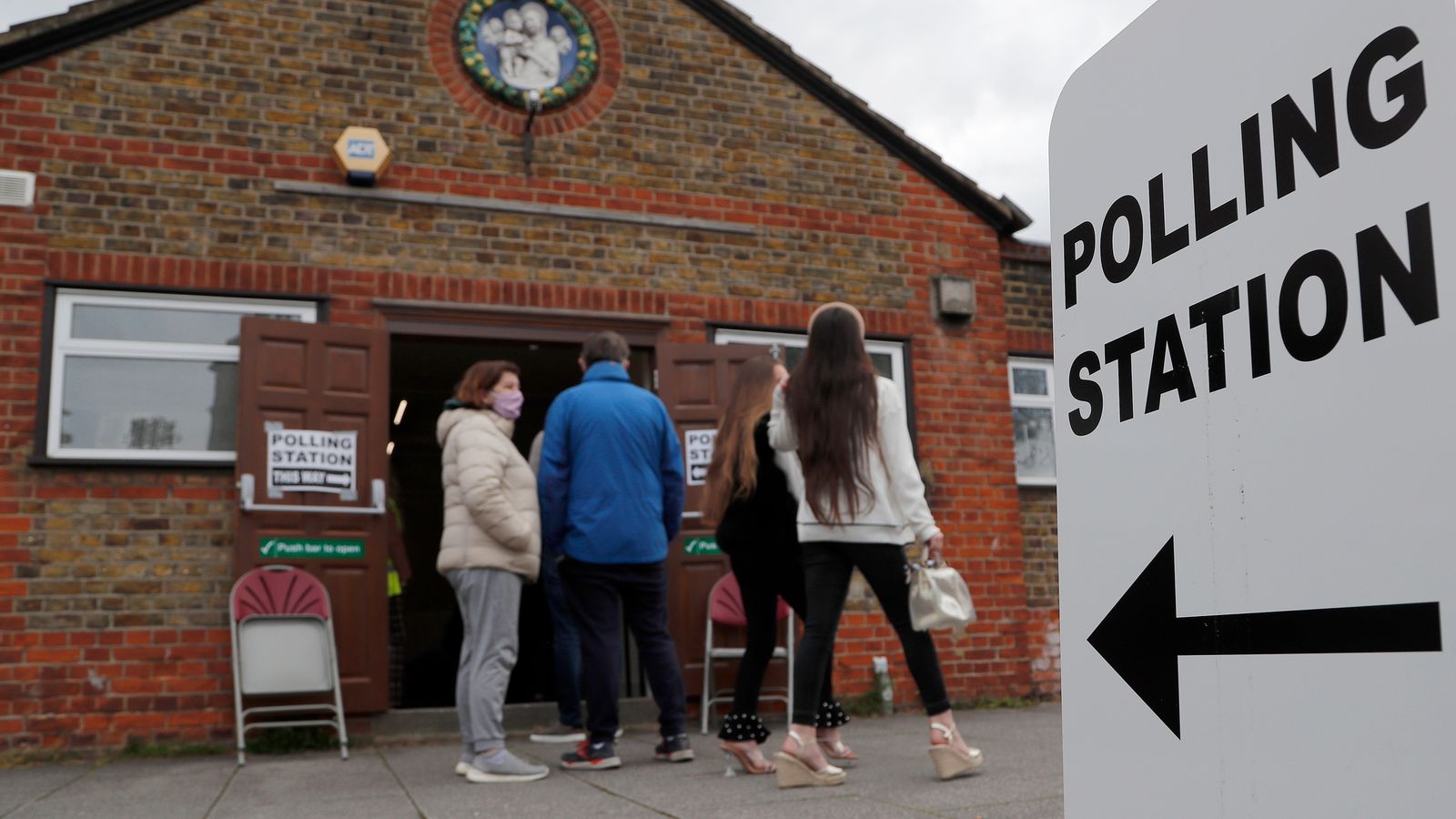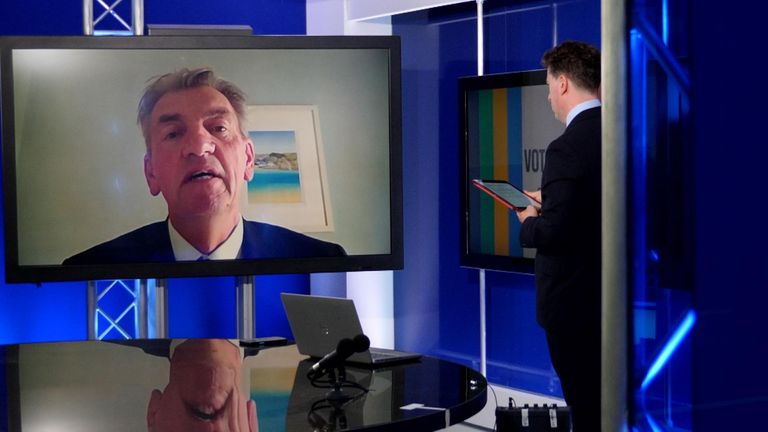There are three ways to judge how well the political parties do on election night.
First, by the number of council seats gained, secondly by the number of councils won and lost and thirdly by looking at vote shares – the proportion of people who vote for each of the main parties.
None of them will give you the full picture, however, as they battle in the early hours to give results the most positive gloss.
The fight has already begun in earnest – with parties’ claims and counterclaims about what to expect.
This is our guide to decoding what they will say.
In this Q&A, I asked Sky’s election analyst Professor Michael Thrasher how he will interpret the results.
Q: Labour say the Conservatives did disastrously in 2019, which is the last time this set of elections took place. They argue the Tories should be judged on whether they are gaining seats, not losing them. Are they right?
Professor Thrasher: “The Conservatives are still the largest party of local government. They’re still defending the most seats this time.
“Why they might lose seats is simply because where they are currently in the national polls is lower than where they were in 2019 in terms of the national equivalent vote.
“In 2019, the Conservatives and Labour each got 31% of the national vote share. And so if the Conservatives are now below 30% and Labour is above 40%, it stands to reason that there’s a large swing from Conservative to Labour since four years ago. And therefore, for that simple reason, the Conservatives will lose seats to its principle opposition at these local elections.
“So yes, they lost 1,300 seats in 2019, but they are in a position where they should lose seats if polling is taken into account because Labour is so much further ahead of them now than it was in 2019.”
Q: The Tories have latched upon your 1,000-seat loss scenario. Are there more realistic alternative scenarios that we should be looking at for them?
Professor Thrasher: “Well, I think Conservative losses are inevitable.
But I think if they can keep those losses down to around 500 to 700, they will feel that Labour isn’t really hurting them a great deal, and possibly also the Liberal Democrats, who they are quite fearful of in parts of southern England like Surrey, Cambridgeshire and Hertfordshire.
“[It would mean] they too are not breaking through and threatening Conservatives in the next general election.
So, I think if they can keep losses down below 500, they will probably believe that they’ve had a reasonably good night at this stage of the parliament, given the way in which the current opinion polls have them below 30%. They will take that, I suspect.”
Read more:
The battleground – where are votes taking place and which matter most?
Explained: everything you need to know about the local elections
Fears over new voter ID rules
Q: Labour is saying a good night for them would be then gaining 400 seats. How does that fit in the benchmarks that you’ve done?
Professor Thrasher: “Well, I think that’s a very modest claim and given two things. Number one is where Labour currently is in the polls – it’s at 43%.
So again, if you recall, in 2019, we were saying that Labour was on 31%. That’s an increase of 12 percentage points on the position four years ago, so they should be doing well, and we think far better than 400 gains.
“Really, that’s a very modest swing from the Conservatives to Labour since 2019. They should really be aiming much higher than that, given what they need to do to win the next general election.”
Q: Often, you hear Labour politicians making the argument that these are not elections happening in their heartlands. These local councils, often shire councils, are not traditional places where Labour has a strong vote – how much validity is there in that?
Professor Thrasher: “That really, if you like, misses the point about the whole exercise of using local elections to calculate a national vote share. Because we take all of this into account.
“The way in which we calculate the national equivalent estimate is simply to look at the change in vote share in wards that voted in 2019 and in 2023.
So, it takes into account where these places are because if a council didn’t have an election, in 2019, we won’t be comparing with that result. So, we’re only comparing wards that are like for like, across those four years.
And for that reason, it doesn’t really matter where the elections are, because we’re looking at changing vote share.”
Q: Labour is keen to avoid comparisons with the local elections in 1995. They say you can’t compare those two, is that fair?
Professor Thrasher: “I don’t think it is fair, quite frankly. The reason being is that if we think about the context of the next general election, Labour requires a swing greater than Tony Blair received in 1997, which in itself remains the postwar record.
“So, I think it’s reasonable to compare with 1995 simply because Labour in 2024 has to do better than Blair did in 1997.
“And then for that reason, if Labour in 2023 is doing much, much worse than Labour did in 1995, then it stands to reason that quite frankly, they’re not in a good position to win the next general election.”
Q: Is it fair to say that Labour traditionally underperform in local elections as compared to general elections?
Professor Thrasher: “It is the case, and our projection allowed for the fact that Labour does perform rather worse in actual local elections than its current national opinion poll rating suggests. So we’ve factored that into our equation.
“It allows for the fact that the Labour lead over the Conservatives in terms of the overall estimate of the national vote at these locations is not going to be as great as the gap that it has in terms of the national opinion polls.”
Q: The Conservatives say a six or seven-point gap behind the Labour party would be a good night – being less than the polls suggest. Is that a fair benchmark to use?
Professor Thrasher: “Well, if we think about the national equivalent vote share from last year, it was 35% for Labour and 33% for the Conservatives.
“So, if they are five points adrift, then they’ve done worse than they did last year.
“This doesn’t suggest the party is catching Labour up necessarily, but they will certainly avoid the situation as in 1995, where Labour was on 47%, and the Conservatives were at 25% – a huge gap between the two parties and where Labour went on to win a landslide.
“I think the Conservatives really need to be within touching distance of Labour, bearing in mind where we are in terms of the parliament and bearing in mind that a general election is probably sometime next year.
“There is a limited amount of time for the Conservatives to catch Labour up, and therefore, they really should be within touching distance of them, not a long way behind.”
Professor Thrasher and his colleague Professor Colin Rallings have drawn up this guide for how to judge the results of the main political parties:
Conservatives
- 1000+ losses: A bad night with a third of all seats defended lost. Tory MPs in marginal ‘red wall’ and southern seats will be worried
- 750 losses: A clear swing to Labour but rather less than opinion polls imply
- 500 losses: The party will try to write this off as “mid-term blues” and argue the gap with Labour can be caught before the general election
- Fewer than 300 losses: Council seats regained from Independents as Labour and Lib Dems fail to prosper
Labour
- 700 gains+: This would be the best local election performance for at least a decade, putting the party on the path to becoming the largest party at Westminster in a general election, even if short of an outright majority
- 450 gains: Results little better than a year ago
- 250 gains: Disappointing in the context of the polls, suggesting limited success in winning back the ‘red wall’
- Fewer than 150 gains: Effectively a step backwards for Sir Keir Starmer and his party
Liberal Democrats
- 150+ gains: Eating into Conservative territory and could put some marginal constituencies in play at the next election
- 50-100 gains: Comfortable enough in their own heartlands but only modest further progress
- Fewer than 50 gains: Still struggling to pose a real threat to the Conservatives in the south




